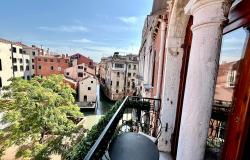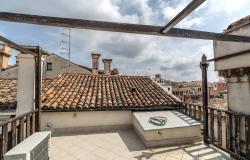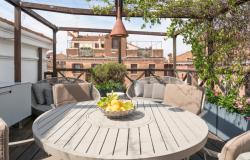An exhibition of costumes from Bernardo Bertolucci's Oscar-winning movie The Last Emperor has kicked off a rich programme of events giving an oriental flavour to this year's Venice Carnevale.
The theme of the 2006 Carnevale, which runs until February 28, is 'Il Drago e il Leone' - the Chinese 'dragon' and the 'lion', the symbol of the Lagoon City's patron, Saint Mark.
The Last Emperor show at Venice's Corderie dell'Arsenale is undoubtedly one of its highlights.
It features the beautiful, Academy Award-winning costumes worn by actors in Bertolucci's 1987 movie about Pu Yi, the last of China's emperors.
They range from the sumptuous imperial clothes donned by the child Pu Yi - he was crowned monarch in 1908 at the age of three - to the grey uniforms he wore when working as a gardener under the Communist regime. Costume designer James Acheson used an army of tailors and dress-makers from all over the world to produce them.
"Two Italians are particularly well loved in China, Marco Polo and Bernardo Bertolucci," said Carnevale Director Maurizio Scaparro at the show's inauguration on Tuesday. "The movie is a story of metamorphosis, the emperor becomes a citizen, an ordinary gardener," said Bertolucci in a video message; a transformation he believes in some way reflects those that China was undergoing when he was shooting the film.
"When we did the first surveys all you saw on the streets were the jackets of Mao and there weren't many smiles. Then jeans, rock music and the beautiful Beijing opera started to appear".
The exhibition is garnished with photography from The Last Emperor shoot.
A separate show at the Ca' Pesaro Museum focuses on the imperial clothes and porcelain of the Qing dynasty (1644-1911), which Pu Yi belonged to.
Another big event is the production of 'Dialoguer-Interloquer' by exiled Chinese dissident Gao Xingjian, the 2000 Nobel Literature laureate. The writer, whose works have denounced Chinese totalitarianism, is directing the play himself. 'Dialoguer-Interloquer', like all of Gao's plays and novels, is banned in China.
Scaparro has also given a prominent position to the most famous historical link between the two faraway cultures, the great 13th-century Venetian explorer Marco Polo.
One of the events is a special literary 'karaoke' called Un Milione di Letture (A Million Readings), in which the public will be invited to read excerpts from Polo's travelogue.
In English the book is known as The Travels of Marco Polo, while its original Italian title was Il Milione (The
Million). It is an original way to re-evoke Polo's epic journey from Venice to the Middle East, then along the Silk Road into the great expanses of China, where he spent 17 years at the summer palace of Emperor Kublai Khan, before heading back via Indonesia and India.
Another show focuses on Matteo Ricci - a 16th-century Italian missionary who is better known in China than he is in his homeland.
Ricci (1552-1610) was a Jesuit who became a mandarin at the court of Ming Emperor Wonli and was the first foreigner in China to be buried with full state honours.
In China he is widely studied at school under his Chinese name Li Madou and the affectionate diminutive Xitai, which means Western Master. Chinese teachers say their charges study him in the same way they do giants of Western literature like Homer.
Until recently little was known about him here but a new film and a series of exhibitions have helped Italy discover the pioneer.
There will also be Chinese dance and music shows and films, as well as meetings with intellectuals and artists
from the land of the Great Wall. Naturally, Carnevale is also staging the traditional series of costume pageants, balls and performances that revive the spirit of the Venetian Republic.
The event, which draws hundreds of thousands of visitors to the Lagoon City every year, takes place in the week before Lent and is believed to date back to the 12th century. The festival was brought to a halt in 1797 when Napoleon put an end to the Venetian Republic.
After taking a sabbatical of almost 200 years, it revived itself with the help of some local enthusiasts in the
1970s.
It is now a big hit with Venetians and tourists alike. City officials say that, at its peak, it attracts around 80,000 visitors a day.Its most distinctive feature is the famous Venetian white mask - worn with a black cloak and a tricorn hat - which can be bought almost everywhere in the city during the festival.
Masks are linked to Carnevale because, during the era of the Republic, it was one of the few periods of the year that the authorities allowed citizens to wear them. Venetians liked them because they enabled people of
different social classes to mingle and get up to mischief together without being recognised.














